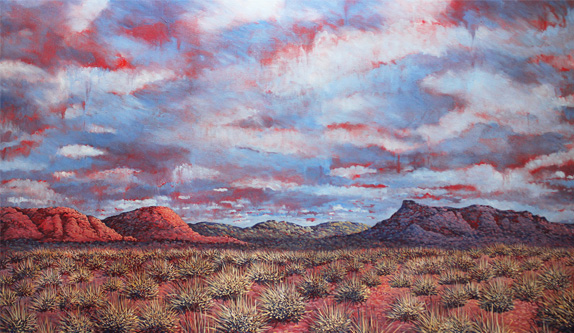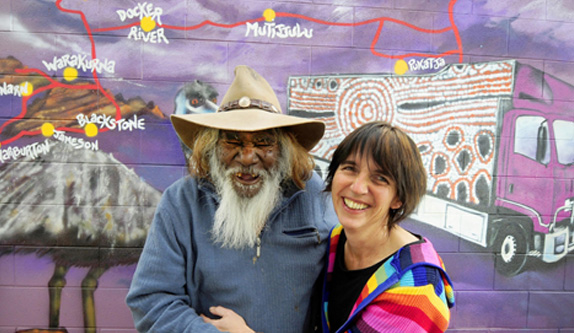Stories and their storytellers are able to continue their journey through generations thanks to the power of art, Gerard Ward says.

The art shown on each canvas of Sarah Brown’s work depicts the crevices, hills and bushland of western desert Australia in gorgeous hues of orange, blue and purple. The tales of these paintings display the illustrious wonder of the Aussie countryside, but what tells a better story is hearing her day job as a health care worker and CEO of Western Desert Nganampa Walytja Palyantjaku Tjutaku (WDNWPT).
For over a decade Sarah and many other passionate people like her have been fighting to help the indigenous communities in the Northern Territory of Australia have better access to dialysis machines. ‘The rates of kidney disease among Aboriginal people in desert communities are very high,’ Brown says. According to Kidney Health Australia, in 2012-2013 almost one in five (18 per cent) Aboriginal and Torres Strait Islander people aged over 18 had indicators of chronic kidney disease. According to The Menzies Institute Of Health Research, the Northern Territory has the highest rate of end-stage renal failure. ‘There’s a number of causes of this, but it’s about rapid culture change, poverty, powerlessness and dispossession,’ she adds. ‘It’s not about alcohol consumption – most of our mob have never touched a drop in their lives.’
Having studied nursing in New South Wales, Sarah worked in the inner city of Sydney before moving to Adelaide in 1990 to work in Aboriginal Health. She eventually moved to Alice Springs in 1992, enjoying her time more out in communities than hospitals. Families were enduring hardships to get essential dialysis machines – the Pintupi people had to travel enormous distances or permanently move up to Alice Springs to get treatment three times a week, meaning leaving their homes behind – and not being on country. ‘In traditional Aboriginal world view, the kidneys hold the spirit,’ Sarah explains. ‘So sick kidneys, sick spirit. The things that keep your spirit strong are being with family, on country, taking part in ceremony and community life.’

Patrick Tjungurrayi and Sarah Brown.
The Pintupi people wanted to get dialysis out bush, but these machines aren’t cheap. Through a grassroots initiative in the year 2000 with artists in Papunya Tula, Sotheby’s and local Northern Territory politicians, a handful of paintings were auctioned off at the Art Gallery of NSW, raising $1.1 million for the WDNWPT – an amazing start. ‘They couldn’t get government to help, so they did it themselves,’ Sarah says. ‘There’s a lot of well-deserved pride in this organisation.’
Since then there has been government funding coming in to support Purple House – the first place out in Alice Springs that could offer care and dialysis. When Sarah first became involved, she knew nothing about dialysis. ‘My first job in 2003 was to write our constitution, get a bank account and get charity status,’ Sarah recalls. ‘I would never have believed that I would be in the same job for close to 14 years, but it’s changing all the time.’
From Purple House’s beginnings in Alice Springs and in Kintore, there are now 24 machines in 11 places, including two on the road. The Purple Truck is bringing dialysis machines to communities via a big purple truck. ‘We knew we weren’t going to be able to have dialysis in every remote community where people wanted to be, so we thought “why not build a truck that can travel and give people at least some access to around the country and have something to look forward to?”’, Sarah says. ‘Medicines Australia donated the money to build the truck, Fresenius donated the dialysis machines and we fundraised to get it out to communities.’
‘If we weren’t around, everyone on dialysis from remote communities would be stuck in Alice Springs, Darwin, Perth and Adelaide with no hope of getting home to see their families,’ Sarah says. ‘A diagnosis of end-stage renal failure was a one-way ticket to town – and home for your own funeral. It caused great hardship and sadness, and a real risk that important cultural knowledge would be lost.’
Art has always been an essential part behind the initiative. Sarah, a keen painter and self-taught artist, began to paint while working out in the countryside as a remote nurse, getting some guidance from local artists like Rod Moss. A fan of the likes of Van Gogh and Post-Impressionism – as well as Australian favourites like Lloyd Rees, Brett Whiteley and the Western Desert painters she’s worked with – her art has now brought her to having her first solo show in Singapore.
Pictures are worth a thousand words, though it’s easy to say these paintings tell a longer tale of the importance of home the connection to the land. The thousands of stories that may not have been passed down generations by communities around Australia may have hope yet, and it’s all thanks to the power of the paintbrush.
Sarah Brown’s solo exhibition ‘Remote’ runs until 24 December at ReDot Fine Art Gallery, 140 Hill Street #01-08, 179369.







